Urinary Reconstruction
What is Urinary Reconstruction?
Urinary reconstruction is a procedure that involves creating 
Urinary Tract Anatomy
The urinary tract normally consists of two kidneys, two ureters, a urinary bladder, and a urethra:
- The kidneys filter your blood and remove water and waste through the urine.
- The urine travels from the kidney to the bladder through tubes called ureters.
- The urine is stored in the urinary bladder and then moves through the urethra to be passed out of the body when you urinate.
When the bladder is removed, urine needs to exit the body in a new way, through a urinary diversion. In all types of urinary diversions, a part of the intestine is surgically converted to either a passage tube for urine to exit the body or a reservoir to store urine (like a normal bladder).
Regardless of the surgical method, urine and stool remain completely separate from each other. (They are two different systems — the urinary and digestive systems — respectively.)
Continent Urinary Diversion
There are two main forms of continent urinary diversion. Both usually involve the surgeon creating a pouch for the urine inside of the body as a replacement bladder. This replacement bladder is formed out of the excess intestine. You’ll either have a stoma replacement where you will use a catheter to remove the urine from the body. The second involves the use of a neobladder. A neobladder is made of the intestine and formed into a pouch within the body. This pouch will then be connected to the urethra and urine will filtrate through the body normally.
Non-Continent Urinary Diversion
A non-continent urinary diversion is going to make use of an ostomy bag. An ostomy bag is a pouch outside of the body that connects through a catheter through the new passage for waste through the stoma. This pouch is continually used to drain urine from the body. These bags are made to fit comfortably under the clothes. All strenuous activity is still approved even with the allocation of the bag on the body.
What to Expect After Urinary Reconstruction and Diversion?
After urinary reconstruction and diversion, it takes one to two months to feel well again and to regain your strength. Don’t hesitate to call your doctor or other healthcare team members for assistance or if you have questions. Their goal for you is to get you back to your lifestyle as soon as possible.
What Restrictions Will I Face After Urinary Reconstruction and Diversion?
People with urinary diversions are usually able to return to the life, work, and hobbies they previously enjoyed:
- Work: Most people can return to their jobs in one or two months, on average. If you have concerns about your line of work or other job hazards, be sure to ask your doctor.
- Activities: After the post-operative period, exercising and participation in sports and other activities are encouraged. Check with your doctor or healthcare team member.
- Diet: There are no eating restrictions. If you have special dietary concerns, ask your doctor or healthcare team member.
- Travel: There are no travel restrictions. You should travel fully prepared with necessary supplies, as you might not be able to purchase all supplies at your destination.

